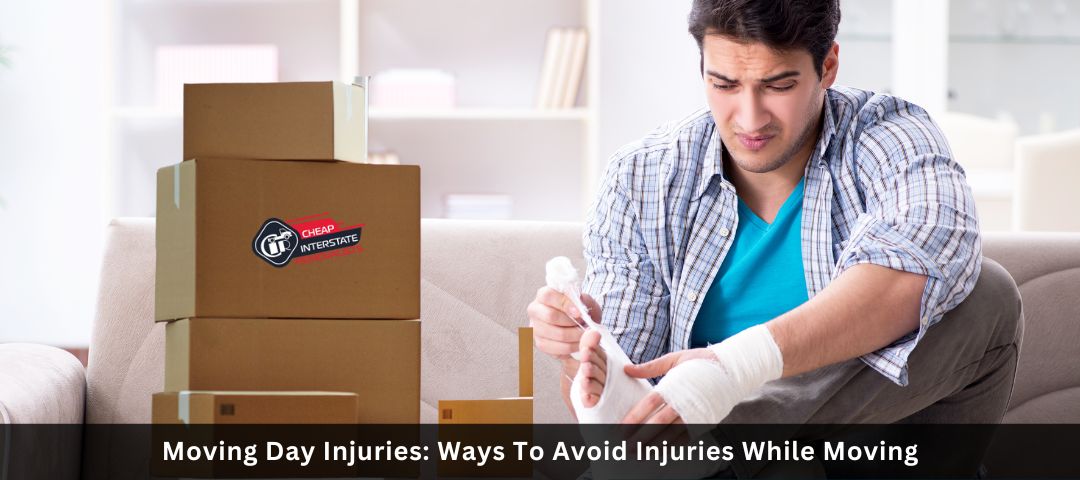While shifting, you run the risk of making errors and overlooking necessary safety measures while seeking to speed up the shifting procedure. This can result in unbearable physical problems.
To ensure a smooth and safe moving experience, it is essential to take precautions to avoid moving day injuries. So, in this blog, Cheap Interstate Removalists has mentioned the list of moving day injuries with their ways to avoid them. This will surely help you manage the relocation challenges and avoid injuries while moving.
Common Moving Day Injuries With Tips To Prevent Them
Accidents while moving might not only hinder your relocation but also have a permanent negative impact on both your finances and your health.
So here are a few recommendations for avoiding injuries while moving:
1. Broken Toes, Hands, Or Fingers
The procedure of relocation often results in broken hands, fingers, and toes. People commonly drop large things on certain body parts, which can lead to chronic pain and general irritation. You may therefore get bodily wounds and fractures.
Tips to prevent fractures and wounds while moving are:
- Wear a pair of sturdy closed-toe shoes and sturdy gloves.
- On the entire day of the relocation, take the pedestrian route.
- Don’t pack crates too full.
- Use strong packaging tape to support the bottom of the boxes.
- Don’t engage in conversation with others around you, and focus on lifting.
2. Strained Back
Back injuries become particularly common throughout moving operations because the majority of moving-related tasks (bending, transferring weight, transporting, etc.) exert pressure on the back.
Moving large objects and large sections of equipment could harm your lower back. In order to avoid any serious injury situations, it is crucial that you take every possible step. To avoid back injury on a moving day, consider implementing these preventive measures:
- To make the operation easier, use the appropriate moving tools, such as straps, dollies, and trolleys.
- Make sure crates are not too heavy so they are simple to handle and transport.
- Ask a friend or family member to assist you in moving big objects so that the weight is distributed among each one of you.
- Know your limitations before attempting to lift something large.
3. Neck And Shoulder Injuries
Your DIY relocation could end up resulting in neck as well as shoulder challenges due to hard lifting. The most prevalent neck and shoulder injuries when shifting are muscular sprains, various damage to the spine, constricted nerves, dislocations, torn nerve endings, and collarbone breakage.
Mild neck and shoulder disorders can be painful and frequently necessitate surgery.
Here are some tips to avoid:
- Maintain Proper Posture: When lifting and carrying items, pay attention to your posture. Keep your back straight and shoulders back. Avoid leaning forward excessively, as this can strain your neck and shoulder muscles.
- Use Proper Lifting Techniques: Bend your knees and use your leg muscles to lift objects rather than straining your neck and back. Hold the object close to your body and avoid twisting your neck while lifting.
- Take Breaks: Moving can be physically demanding, and constant strain on your neck can lead to injury. So, take regular breaks to stretch and relax your neck and shoulders. Gently roll your shoulders and perform neck stretches to relieve tension.
- Use Supportive Equipment: For heavier items, consider using equipment like dollies, hand trucks, or straps to assist with lifting and carrying. These tools can help distribute the weight more evenly and reduce the strain.
4. Knee And Ankle Injuries
One of the most frequent types of moving day injuries is a knee or ankle injury. Knees and ankles, being some of the weak joints in the body, are susceptible to injury with relative ease.
The knees bear a significant workload among the body’s major weight-bearing joints. Overexertion can lead to sprains, fractures, dislocations, and meniscus injuries. Meanwhile, activities like lifting, pulling, and carrying heavy objects can result in twisted or injured ankles.
Here are some easy recommendations you might use to avoid being hurt:
- Handle bigger goods with caution.
- Never hurry up to complete the task. Take breaks and relax sufficiently between shifts to move smoothly and prevent damage.
- Put on security gear such as braces, kneepads, and footwear that is durable.
- The box’s capacity should not exceed your body limits. So, don’t carry too much to complete the task quickly.
- You can lift and slide significant objectives with the appropriate tools and machinery.
4. Hernias
A hernia is an organ or tissue protruding through a peculiar hole. An incision or weakening in the abdominal wall muscles, along with tension, may cause this. You must consequently proceed with relocation with the greatest caution and get a sufficient amount of sleep.
Tips to avoid this injury during a move:
- Avoid overloading boxes.
- Keep packaging as compact as possible.
- Do not try to lift or operate equipment or gadgets by yourself.
- Utilize the effective lifting technique.
5. Cuts And Scrapes
Engaging with sharp things while shifting increases your risk of hurting yourself from cuts and scratches. Items like box cutters, cutting instruments, culinary utensils, glasses, etc., are among these dangerous objects.
While you’re preparing for a local or interstate move, there’s a decent possibility you’ll run into a few.
So here is some advice for preventing wounds and scratches while moving:
- Be sure to layer up in perfect moving day clothes.
- Always have an ample supply of gauze and antibacterial products on hand.
- Use gloves and proper closed-toe shoes to avoid wounds during a move.
Other Health Risks On Moving Day
The likelihood of dehydration increases when moving during intense physical activity, as you might not be drinking as much water. Regardless of this, your system will still need an abundance of liquids to support the vigorous workouts you will be performing on a moving day. Therefore, it is advisable to stay hydrated during a move.
To swiftly drop your internal humidity, keep a cool, soaked towel handy to lay on the upper part of your neck if you begin to feel excessively hot while moving. This will help you to stay healthy and comfortable during a move.
Conclusion
If not done effectively, shifting may be a tricky and unsafe process. However, by following the guidelines outlined in this article, such as practicing proper lifting techniques, seeking help from others, and many others, you can significantly minimize the stress of your move and reduce the risk of moving day injuries. These simple yet effective measures to avoid injuries while moving will contribute to a smoother and safer relocation experience.
If it’s too heavy to lift, ask for help! Cheap Interstate Removalists is here to assist you with the best moving services in Australia. Our professional removalists in Sydney or any part of Australia will take every safety measure to prevent moving day injuries. Our movers will be handling your move with expertise, productivity, and diligence and conducting it in a way that effectively avoids relocating injuries and mishaps and ensures a smooth relocation process. So, just give us a call at 0480 033 100 or visit our website, www.cheapinterstateremovalists.com.au book our professional interstate movers in Australia. You can also mail us at info@cheapinterstateremovalists.com.au to shift your belongings without any mishap. Happy Moving!
Related Blogs
A Guide to Hiring Interstate Removalists in Adelaide
Combining interstate moving is indeed the most exciting new phase of your life, but let’s be realistic—these activities are very stressful in their own right. From packing up the whole house to coordinating logistics over long distances, moving is tough. This is where...
Moving Made Easy: Interstate Removalist Gold Coast Services
While moving to another state can be stimulating, it can also be a great burden. Family functionings, job reassignments, or changes of scenery, nonetheless, make packing, moving, and unpacking feel like a very tiring process. This is where professional interstate...
How to Choose the Right Size Truck for Your Sydney to Melbourne Interstate Move
The most critical choice you'll need to make in the event of preparing to relocate from Sydney to Melbourne is the right size truck that will facilitate your move. Thus, ensuring that you choose the correct vehicle will determine the efficient transfer of goods safely...

The Cheap Interstate Removalists Team boasts 5+ years of experience writing informative content about moving and packing. Our team of moving experts understands the hassles of relocating to Brisbane. Get helpful tips and advice for your move here. We are the #1 Removalists in Brisbane.




